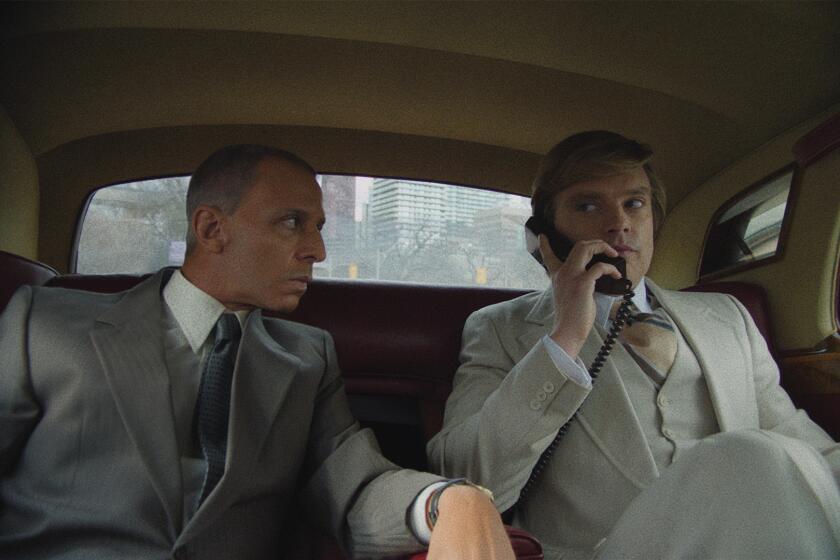Rev. Howard Finster, 84; His Folk Art Attracted a Wide Audience
- Share via
The Rev. Howard Finster, a Baptist preacher turned folk artist who called his crudely drawn, brightly colored artworks “sermons in paint,” died Monday at a medical center in Rome, Ga.--near his rural home in Summerville--of congestive heart failure. He was 84.
Finster’s work began to gain popularity in New York art galleries in the early 1980s, and received its widest exposure when the Georgia-based rock band R.E.M. asked him to create the cover for its 1984 album “Reckoning.”
A year later, the band Talking Heads, made up of former art students, commissioned Finster to design the cover of its “Little Creatures” recording. By the late 1980s, it was said, Finster’s work, which included cutouts, sculptures and assemblages, had become so hot that it was selling before the paint was dry.
In 1989, his art became the focus of a touring retrospective organized by New York’s Museum of American Folk Art. Liza Kirwin, a collector for the Smithsonian archives, called Finster “the Andy Warhol of the South.”
The artist himself was always amazed by his own popularity: “People come here and buy the paint rags out of my studio!” he once said, clearly astonished.
Finster was part of the segment of the art world known as the “outsider movement”--self-taught artists working outside the aesthetics of formal art training.
“When Christ called his disciples, he called fishermen; he didn’t call nobody from a university,” Finster said in a 1990 interview.
His childlike, two-dimensional paintings, infused with evangelistic themes, were often accompanied by text scrawled in crooked block letters: “Hell is a hell of a place,” said one. Finster also incorporated pop culture icons into his work, including the Coke bottle, the Cadillac and a favorite folk hero, Elvis Presley.
“He was able to reach more people with his work as a self-taught artist than anyone else ever has,” said Lynne Spriggs, curator of folk art for Atlanta’s High Museum of Art, in an interview Tuesday with The Times. The museum holds the world’s largest collection of Finster works: 160 pieces.
“He was a tremendous talent--a real visionary--and brilliant in finding ways to get the word out to a very large population,” Spriggs added. “He always said he never met a person he did not love.
“His message was divided between the possibility of salvation and the coming destruction of the world. Many of his works were very apocalyptic, and he drew on historical figures from Martin Luther King to Elvis Presley. His work dealt not with abstract things, but with social and political issues. He was born in 1916; he’d seen a lot.
“He was always most interested in the idea that, just as God invented man, man also invented incredible things,” she said. “He called upon members of the human race to use their imagination, their convictions and sense of faith to get themselves on the ship before it was too late.”
In a 1988 interview, Finster said: “All I know is that I have visions of other worlds--and if I didn’t have visions of other worlds, I’d be miserable because I can’t adapt to a world like this.
“I had a father, a mother and 13 sisters and brothers, and I watched them all suffer and die because that’s the kind of world this is. The only way out is to have faith in another world.”
Finster was born on a small farm in DeKalb County, Ala., and became a Baptist preacher at 16. He began having visions at 3, he once said, when he saw his dead sister descending from heaven while he was playing in the family tomato patch.
For more than three decades, he traveled through Alabama, Georgia and Tennessee, preaching the gospel at tent revivals and supporting himself with odd jobs such as plumbing and bicycle repair.
Finster became an artist because of another message from on high, one that didn’t come until he was 60 years old. While patching a bicycle, he spilled a blob of white paint on his thumb and perceived a face in the paint. He had what he called “a blush feeling telling me I had to paint sacred art.”
In 1961, Finster established his three-acre Paradise Garden, which he called a “folk art haven” built on filled swampland behind his home in Pennville in northwest Georgia. It includes mosaic concrete paths, a giant concrete boot, the Tomb of the Unknown Body and Finster’s folk art chapel. Now, the garden is largely owned by the High Museum.
Finster is survived by his wife, Pauline Freeman Finster; four daughters; a son; 15 grandchildren; and 15 great-grandchildren.
More to Read
The biggest entertainment stories
Get our big stories about Hollywood, film, television, music, arts, culture and more right in your inbox as soon as they publish.
You may occasionally receive promotional content from the Los Angeles Times.










